1. Introduction
 Some time ago we had the chance to review the first batch of Intel's 45nm quad-core cpu processors code-named Yorkfield and today we will examine the latest and fastest Wolfdale C2D processor, the Intel C2D E8600.
Some time ago we had the chance to review the first batch of Intel's 45nm quad-core cpu processors code-named Yorkfield and today we will examine the latest and fastest Wolfdale C2D processor, the Intel C2D E8600.
All the latest Wolfdale processors come with a 6MB L2 cache and feature support a 1333MHz FSB.
Let's start with a quick comparison amongthe various C2D series of processors.

 The Intel E8600 has several "new" features/improvements compared with previous Wolfdale processors. The differences between C0 and E0 core steppings may not interest you ta all, but there are present and will hopefully offer higher overclocking.
The Intel E8600 has several "new" features/improvements compared with previous Wolfdale processors. The differences between C0 and E0 core steppings may not interest you ta all, but there are present and will hopefully offer higher overclocking.
According to an Intel document there is a new function called "Power Status Indicator", that allows motherboards drop their VRM down from a multi-phase circuit to a single-phase circuit to save power at idle state.

There were also two additional instructions added to the instruction set, the XSAVE and the XRSTOR, neither of which are world changing. Lastly, the E0 stepping features a step towards being green with the introduction of a halide-free package.
- Specifications
sSpec Number |
SLB9L |
CPU Speed |
3.33 GHz |
PCG: |
06 |
Bus Speed |
1333 MHz |
Bus/Core Ratio |
6~10.0 |
L2 Cache Size |
6 MB |
L2 Cache Speed |
3.33 GHz |
Package Type |
LGA775 |
Manufacturing Technology |
45 nm |
Core Stepping |
E0 |
CPUID String |
10676h |
Thermal Design Power |
65W |
Thermal Specification |
72.4°C |
VID Voltage Range |
0.85V – 1.3625V |
Box Order Code |
BXC80570E8600
BX80570E8600 |
OEM Order Code |
AT80570PJ0936M |
2. Retail package, installation
The Intel Core2Duo E8600 costs around 235 Euros as found at several online stores.
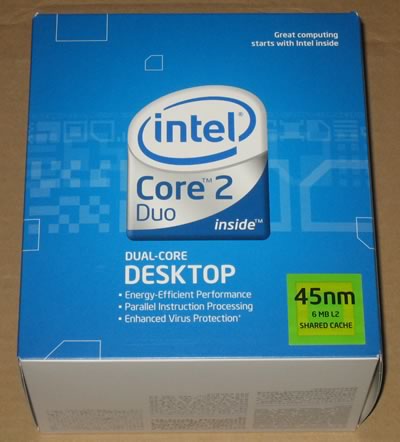

Taking a quick look at the included cpu cooler, we can see that its much smaller than what we have seen with 65nm Intel C2D processors.

- Installation
There isn't much to tell here but as always, be careful when installing the CPU! After connecting all the nessecery power cables, you can power up your system.
Using the latest CPU-Z we can see more details about the installed processor. The CPU multiplier is highly configurable (6~10x ) allowing us to feel that this processor would have wide overclocking margins.

The default core voltage is around 1.224V and the idle temperatures are really low.
Idle mode:
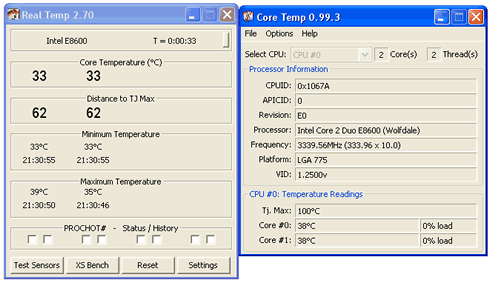
Full load:

It seems to be a difference of 5 degrees Celcius between the measurements reported by the RealTemp and the CoreTemp applications. Most people tend to agree that RealTemp is better but anyway you can use both.
For our tests we used an Asus P5Q Deluxe motherboard with OCZ DDR2-1150 SLI certified memory installed. Note that the tests with other processors inlcuded in the following comparison charts were done using a a different motherboard/memory so there might be some minimal differences in raw numbers.

The Asus P5Q Deluxe is also based on the 45nm technology also so it is expected to match well with the E8600 series.

Below is the used testbed configuration
- CPU Cooler: Scythe Mugen
- Motherboard: Asus P5Q Deluxe BIOS 0901 beta
- Memory: 2x1GB OCZ DDR2-1066 (1067 @ 5-5-5-15-2T, 2.20V)
- VGA: MSI 7600GT Silent with latest Nvidia drivers installed
- HDD: WD 80GB SATAI (primary)
- HDD: WD 80GB SATAI (secondary)
- Operating system: Windows XP SP2 with all latest updates installed
- Operating system: Windows VISTA 32bit SP1 with all latest updates installed
We used a variety of benchmark software to measure the performance of the processor with the two testing platforms
- Office/Benchmarks (WinXP)
- Sisoft Sandra 2008 SP2
- Everest Lavasys Ultimated Edition 2007 v4.50
- SuperPI Mod v1.5XS
- wPrime v1.55 (stable)
- Cinebench vR10
- x264 Benchmark
- x264 HD Benchmark
- SysMark 2007 Preview
- TMPGEnc 4.0 Xpress
- Gaming/Benchmarks (VISTA 32bit)
- PC Mark Vantage v1.00 Nov Edition
- 3D Mark06 v1.2.0
- Crysis Retail v1.20
- Unreal Tournament 3 Demo
3. Benchmarks - Everest Ultimate Edition, SiSoftware Sandra
- Everest Ultimate Edition
 EVEREST Ultimate Edition is a system diagnostics and benchmarking solution for enthusiasts PC users, based on the EVEREST Technology.
EVEREST Ultimate Edition is a system diagnostics and benchmarking solution for enthusiasts PC users, based on the EVEREST Technology.
During system optimizations and tweaking it provides essential system and overclock information, advanced hardware monitoring and diagnostics capabilities to check the effects of the applied settings.
CPU, FPU and memory benchmarks are available to measure the actual system performance and compare it to previous states or other systems. Furthermore, complete software, operating system and security information makes EVEREST Ultimate Edition a comprehensive system diagnostics tool that offers a total of 100 pages of information about your PC. The software has also build-in tests for memory and CPU/FPU.
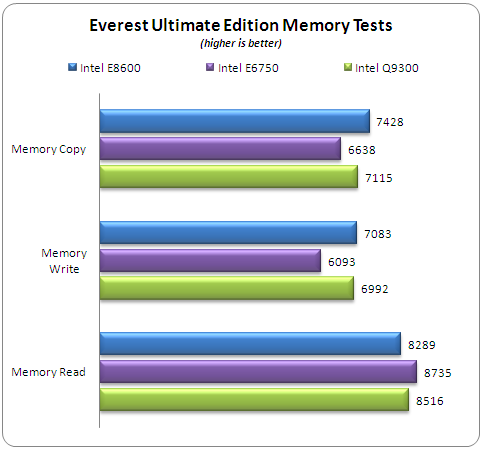
Getting into the first batch of tests, the memory performance seems to be affected from the increased MHz of the Intel C2D E8600 processor. Since most tests nowadays use all the cores of processors, the Intel C2Q 9300 had the highest score in all of them..

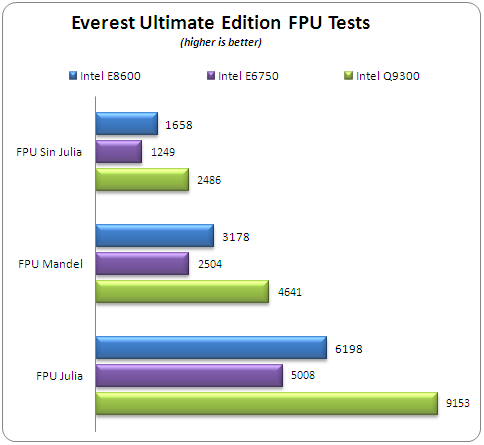
 SiSoftware Sandra (the System ANalyser, Diagnostic and Reporting Assistant) is an information & diagnostic utility. It should provide most of the information (including undocumented) you need to know about your hardware, software and other devices whether hardware or software. It works along the lines of other Windows utilities, however it tries to go beyond them and show you more of what's really going on. Giving the user the ability to draw comparisons at both a high and low-level. You can get information about the CPU, chipset, video adapter, ports, printers, sound card, memory, network, Windows internals, AGP, PCI, PCIe, ODBC Connections, USB2, 1394/Firewire, etc. Sisoft Sandra offers a variety of tests for Memory and CPU.
SiSoftware Sandra (the System ANalyser, Diagnostic and Reporting Assistant) is an information & diagnostic utility. It should provide most of the information (including undocumented) you need to know about your hardware, software and other devices whether hardware or software. It works along the lines of other Windows utilities, however it tries to go beyond them and show you more of what's really going on. Giving the user the ability to draw comparisons at both a high and low-level. You can get information about the CPU, chipset, video adapter, ports, printers, sound card, memory, network, Windows internals, AGP, PCI, PCIe, ODBC Connections, USB2, 1394/Firewire, etc. Sisoft Sandra offers a variety of tests for Memory and CPU.
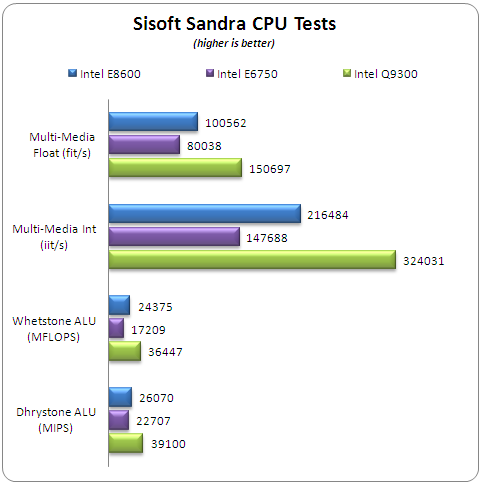
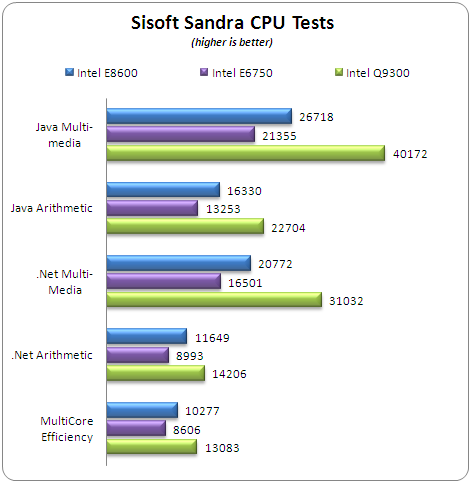
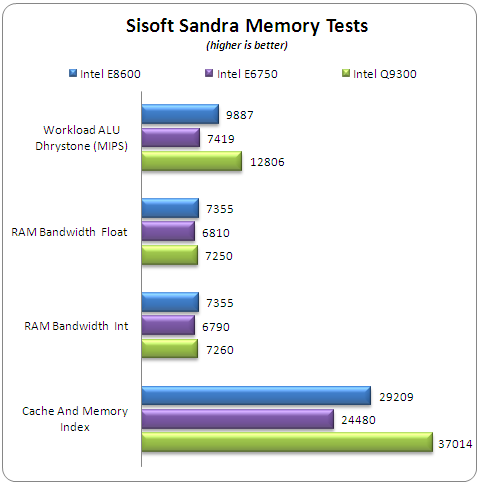
The Sisoft Sandra memory tests confirmed that the memory performance of the Intel C2D E8600 is increased, compared with the Q9300. However in most of the other benchmarks, it falls much behind.
4. Benchmarks - PCMark Vantage, SYSmark 2007 Preview
 PCMark Vantage is a hardware performance benchmark for PCs running 32 and 64 bit versions of Microsoft Windows Vista.
PCMark Vantage is a hardware performance benchmark for PCs running 32 and 64 bit versions of Microsoft Windows Vista.
PCMark Vantage is perfectly suited for benchmarking any type of Microsoft Windows Vista PC from multimedia home entertainment systems and laptops to dedicated workstations and hi-end gaming rigs. Regardless of whether the benchmarker is an artist or an IT Professional, PCMark Vantage shows the user where their system soars or falls flat, and how to get the most performance possible out of their hardware.
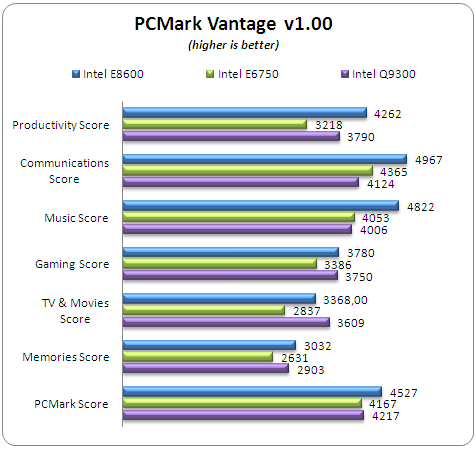
The PC Mark Vantage includes many 2D applications so the increased speed would give the E8600 an advantage compared to the other two processors. The PC Mark score reached the 4527.
 BAPCo's SYSmark 2007 Preview builds upon its predecessors and is the next generation of benchmark
utilities that unitiliaze real life applications like: Adobe After
Effects 7, Adobe Illustrator CS2, Adobe Photoshop CS2, AutoDesk 3ds Max
8, Macromedia Flash 8, Microsoft Excel 2003, Microsoft Outlook 2003,
Microsoft PowerPoint 2003, Microsoft Word 2003, Microsoft Project 2003,
Microsoft Windows Media Encoder 9 series, Sony Vegas 7, SketchUp 5 and
WinZip 10.0.
BAPCo's SYSmark 2007 Preview builds upon its predecessors and is the next generation of benchmark
utilities that unitiliaze real life applications like: Adobe After
Effects 7, Adobe Illustrator CS2, Adobe Photoshop CS2, AutoDesk 3ds Max
8, Macromedia Flash 8, Microsoft Excel 2003, Microsoft Outlook 2003,
Microsoft PowerPoint 2003, Microsoft Word 2003, Microsoft Project 2003,
Microsoft Windows Media Encoder 9 series, Sony Vegas 7, SketchUp 5 and
WinZip 10.0.
SYSmark 2007 Preview is an application-based benchmark that reflects
usage patterns of business users in the areas of Video creation,
E-learning, 3D Modeling and Office Productivity. This new release
includes a refreshed set of applications. All results are
directly comparable between various configurations and operating
systems.
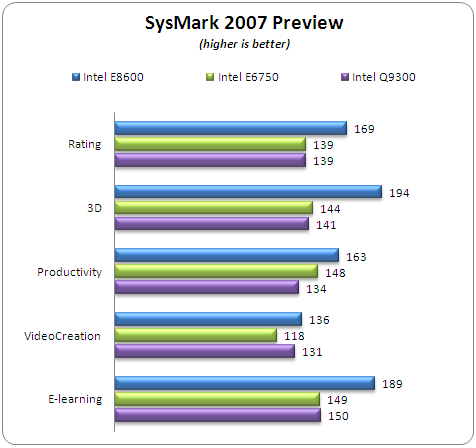
The overall SysMark 2007 Preview score for the Intel E8600 CPU was much higher than the Intel E6750 & Q9300 processors.
5. Benchmarks - CINEBENCH, x264 HD Benchmark, TMPGEnc 4 Xpress
 MAXON CINEBENCH is based on MAXON's animation software, CINEMA 4D, which
is used extensively by studios and production houses worldwide for 3D
content creation.
MAXON CINEBENCH is based on MAXON's animation software, CINEMA 4D, which
is used extensively by studios and production houses worldwide for 3D
content creation.
MAXON software has been used in blockbuster movies
such and Spider-Man, Star Wars, The Chronicles of Narnia and many more.
MAXON CINEBENCH runs several tests on your computer to measure the
performance of the main processor and the graphics card under real
world circumstances. The benchmark application makes use of up to 16
CPUs or CPU cores and is available for Windows (32-bit and 64-Bit) and
Macintosh (PPC and Intel-based). The resulting values among different
operating systems are 100% comparable and therefore very useful with
regard to purchasing decision-making.
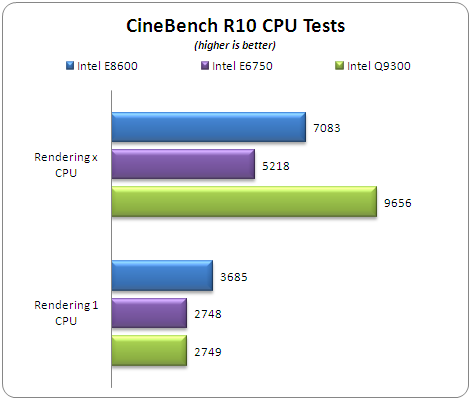
The CineBench R10 benchmark uses all four cores of Intel Q9300 therefore, it can render faster the test image, aproximately x2 times faster. In single core tests, the E8600 is much faster.
- x264 HD Benchmark
x264 Benchmark utilizes the next generation of Video Encoding benchmarks with support
for x264 codec that is considered to be one of the most demanding for
Video applications. Simply put, it is a reproducible measure of fast your machine can encode a short, HD video clip to a high quality x264 video file. It's nice because everyone running it will use the identical video clip and software. The video encoder (x264.exe) reports a fairly accurate internal benchmark (frames per second) for each pass of the video encode and it also uses multi-core processors very efficiently. All these factors make this an ideal benchmark to compare different processors and systems to each other.
The benchmark procedure is very simple, you just run a batch file
that encodes the same file four times. Two different results are presented, one for the first pass and another one for the second one. The average performance is illustrated in the table below.
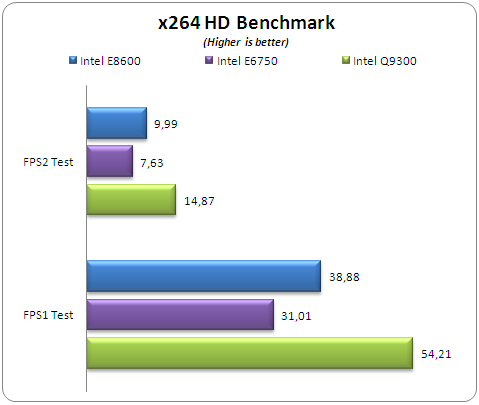
The x264 HD benchmark really tests the cpu, since it uses 100% of it. As was expected the Intel Q9300 is faster by almost 30% compared to the E8600.
- TMPGEnc 4 Xpress
TMPGEnc came from Tsunami MPEGEncoder. Encoding time will automatically be faster as CPU speed gets faster! TMPGEnc converts *.AVI files to MPEG1, the format which is used in VideoCDs. Using a variety of options in TMPGEnc, you can compress your video file in high quality. TMPGEnc enables you to adjust bitrate, quantize matrix, GOP structure, interlacing and many other parameters so that you can create the most appropriate movie file depending on your needs.
For our test we use an AVI file sixed 350MB encoded with Xvid (Mpeg4 ASP) codec. We use the build-in Mpeg4 ASP/AVC MediaEncoder profile and by dividing the total frames via needed encoded time, we get the average frame/sec speed of each processor.
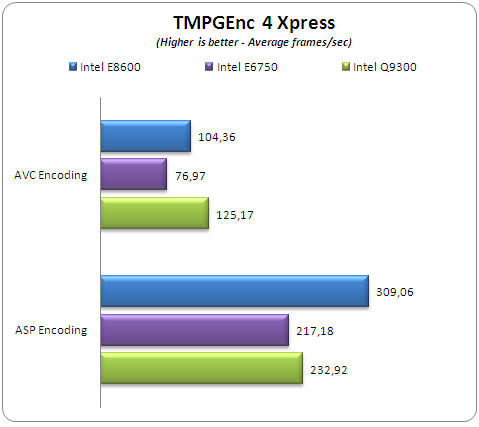
The TMPGEnc 4 Xpress agve us some interesting results. With ASP encoding, the performance of the Intel E8600 is very good, since the ASP encoding doesn't use all four cores of Q9300. However when we selected the AVC profile, the performance boost we got by the Q9300 was big enough to justify its retail price.
6. Benchmarks - SuperPI, wPrime
SuperPI has become an utility to benchmark modern systems. In August 1995, the calculation of pi up to 4,294,960,000 decimal digits was succeeded by using a supercomputer at the University of Tokyo. The program was written by D.Takahashi and he collaborated with Dr. Y.Kanada at the computer center, the University of Tokyo. This record-breaking program was ported to personal computer environment such as Windows NT and Windows 95 and it is called Super PI.

The software offers up to 32M calculations of PI numbers. For all the CPUs, we tested up to 8M calculations:
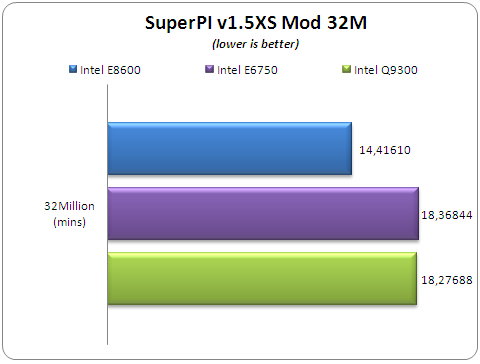
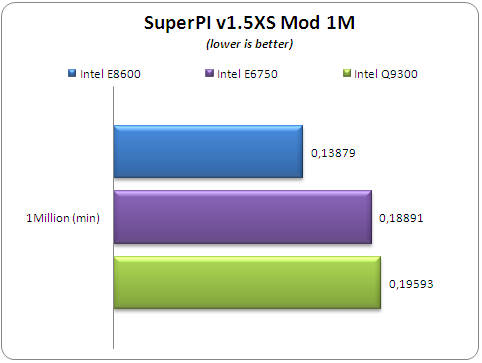
The absolute raw speed of the E8600 shows its teeth in the SuperPI benchmark.
- wPrime
wPrime is a benchmarking application designed to use a highly multithreaded approach to calculating the square-roots of large amounts of numbers (up to 32 billion at this stage!)
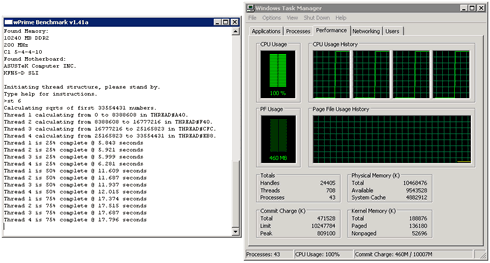
wPrime uses all four cores of quad processors, therefore it can finish the fask much faster than a C2D.

The Intel E8600 needs 25.797 seconds to finish the task, while the Q9300 needs just 17.250 seconds.
7. Benchmarks - 3DMark06, Crysis, Unreal Tournament 3 Demo
 3DMark 06 is the worldwide standard in advanced 3D game performance benchmarking. The software uses advanced real-time 3D game workloads to measure PC performance using a suite of DirectX 9 3D graphics tests, CPU tests, and 3D feature tests. 3DMark06 tests include all new HDR/SM3.0 graphics tests, SM2.0 graphics tests, AI and physics driven single and multiple cores or processor CPU tests and a collection of comprehensive feature tests to measure next generation gaming performance today.
3DMark 06 is the worldwide standard in advanced 3D game performance benchmarking. The software uses advanced real-time 3D game workloads to measure PC performance using a suite of DirectX 9 3D graphics tests, CPU tests, and 3D feature tests. 3DMark06 tests include all new HDR/SM3.0 graphics tests, SM2.0 graphics tests, AI and physics driven single and multiple cores or processor CPU tests and a collection of comprehensive feature tests to measure next generation gaming performance today.
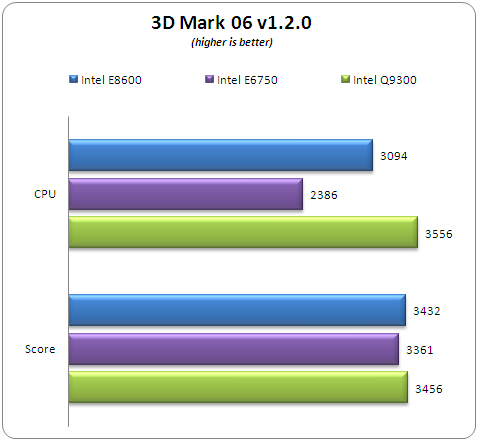
3DMark's overall score depends on the processor. If we believe what 3DMark 06 says, the Intel Q9300 should be faster in games, even by a small margin, compared with Intel E8600. Is that true? Let's find out by looking at the gaming results after running Crysis (1024x768) CPU benchmark and Unreal Tournament 3 Demo.
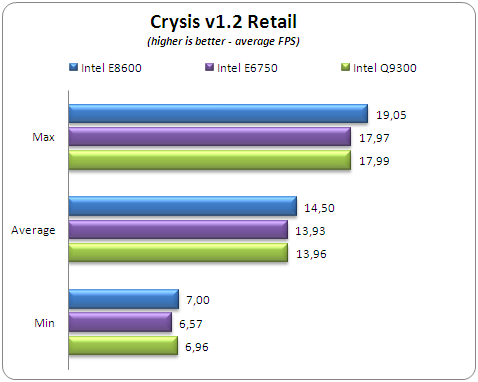
With Crysis the Intel E8600 was somewhat faster. However there shouldn't be any practical difference between them in real life applications. In fact, the Intel Q9300 has more chances to work better with upcoming games since they will be designed to take advantage of all four available cores.

With Unreal Tournament 3 demo, we saw some small performance gain, in favor of the Q9300, but again it shouldn't be considered as so important.
8. Overclocking
The Intel E8600 should have high overclocking margins, at least this is what many techies claim around the world. When paired with a P45 motherboard, things should be even better :-)
Starting from scratch, the Intel C2D E8600 has a vCore range of 0.85V – 1.3625V, according to the official specifications. This means that you are "safe" between those margins. The retail box indicates that the CPU's max vCore is around 1.26V so we started at this point. We set 1.26V at the Asus bios and we increased the FSB until we reached a stable point of 3.90GHz! That's around 600MHz higher by using "stock" voltage! The temperatures are very low 42~60 Celcious (idle/load coretemp).

Next we tried to find the maximum FSB our cpu could handle, of course with the specific motherboard. We left most of the settings at Auto and set the internal multiplier at x6. Without much effort we reached the 550MHz, which should be more than enough for your overclocking needs. There are several reports saying that you can go up to 600MHz.
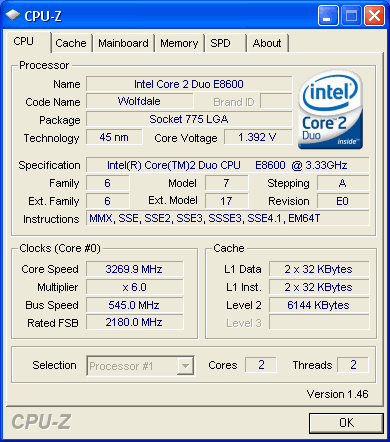
But let's try to push our processor even higher than 3.90GHz. The next step that we reached without any problem was the 4.20GHz. The system was totally stable for everyday use, and the vCore of 1.344V shows that we are still within the safe margins. The temperatures was 47~67 Celcious (idle/load coretemp). But there should be room for higher speeds..
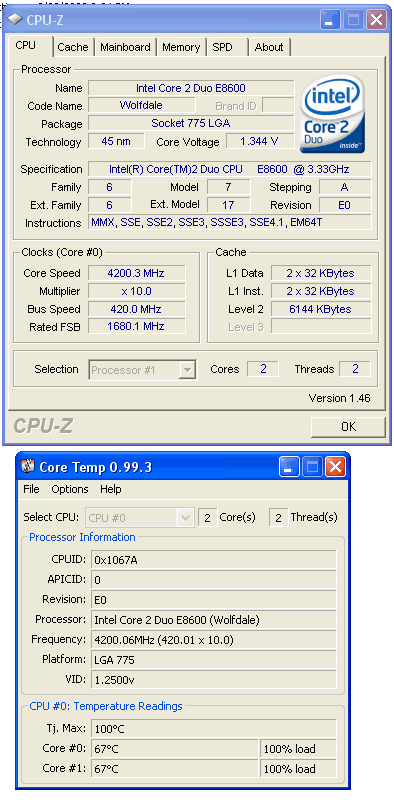
Placing vCore at 1.40V we managed to get another 150Mhz boost, but the CPU temperature increased.

Pumping up vCore at 1.50V we reached 4.50GHz, but our air cooling system was reaching its limits, since the reported temperatures reasched the 70~90 degrees Celcious!

There is good chance to go ever higher with some more BIOS tweaking and water cooling. We feel that the best overclocking point would be around 4.20GHz, since we are still within the safe voltage range.
It would be interesting to compare, an overclocked E8600 with an overclocked Q9300 at its maximum speeds:
Benchmark |
Intel Q9300@3.52GHz |
Intel E8600@4.20GHz |
% Difference (in favor of Q9300) |
x264 HD Benchmark |
43.51 |
30.14 |
+44.35% |
SuperPI |
4.08969 |
3.67875 |
-11.17% |
SysMark 2007 Preview |
170 |
191 |
-11.00% |
CineBench R10 |
15307 |
13483 |
+13.53% |
TMPGEnc 4 Xpress |
246.03 |
255.01 |
-3.52% |
wPrime |
13.656 |
25.016 |
+33.81% |
PCMark Vantage |
4910 |
4985 |
-1.50% |
3DMark 06 |
3527 |
3490 |
+1.06% |
The comparison numbers does show the truth. When an application uses all four cores of the Intel Q9300 processor, there is no real comparison. Again in 2D applications, where the processor speed has more meaning, the E8600 seems to be 11% faster than the quad-core Q9300. Lastly, in the game test, we didn't have the important differences we expected.
9. Conclusion
 The Intel E8600 processor is a very interesting addition to the 45nm family. It is currently the fastest C2D cpu available on the market. The 6MB of L2 cache is present and hopefully the 45nm technology helps you get low temperatures and high overclocking margins.
The Intel E8600 processor is a very interesting addition to the 45nm family. It is currently the fastest C2D cpu available on the market. The 6MB of L2 cache is present and hopefully the 45nm technology helps you get low temperatures and high overclocking margins.
Getting to the fun point, we did manage to push the CPU at 4.45GHz , even our air cooling system was reaching its limits at those levels. We feel that most users could be easily reach the 4.20GHz using smaller coolers, although using a more efficient cooler than the bunled one would be required.

The retail price brings it at the point where users may wonder, should I buy the E8600 or the Q9300? Both products have exactly the same price but different philosofy and destination.
After finishing all tests, we have no wonder who will use each processor. If you are going to use your PC mainly for office/game use, then the E8600 may be more suitable for you. Audio/Video encoding applications would be highly benefited from the four cores of Q9300. Both products are highly overclockable and should give a significant performance boost. If you already have a E8400/8500 there is no reason to upgrade - in fact, getting an E8500 at 150 Euros may be even more a reasonable move and save you 85 Euros to invest in extra memory :-)